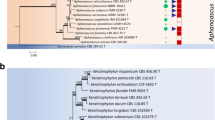Abstract
Neoarachnotheca is proposed as a new genus of Onygenales. The outstanding generic characteristics are white, spherical ascomata with a wall formed by a network of hyphae and spherical, subhyaline ascospores with an irregular sheath. Nt. keratinophila, the type species, characterized by wavy peridial hyphae has been isolated from marine and river sediments and Myriodontium keratinophilum is its anamorph. Nannizziopsis tropicalis is proposed as a new species based on a strain isolated from soil in Burundi. RFLPs analysis of ITS and 5.8S rDNA support these proposals. The differences with related genera are discussed.
Similar content being viewed by others
References
Arx JA von (1974) The genera of fungi sporulating in pure culture. 2nd. Ed., Vaduz
____ (1987) A re-evaluation of the Eurotiales. Persoonia 13: 273–300
Ajello L & Georg LK (1957) In vitro hair cultures for differentiating between atypical isolates of Trichophyton mentagrophytes and Trichophyton rubrum. Mycopath. Mycol. Appl. 8: 3–17
Apinis AE (1964) Revision of British Gymnoascaceae. CMI Mycol. Papers No. 96
____ (1970) Concerning Rollandina. Trans. Br. Mycol. Soc. 55: 499–502
Cano J, Guillamón JM, Vidal P & Guarro J (1996) The utility of mitochondrial DNA restriction analysis in the classification of strains of Chrysosporium (Hyphomycetes). Mycopathologia 134: 65–69
Currah RS (1985) Taxonomy of the Onygenales: Arthrodermataceae, Gymnoascaceae, Myxotrichataceae and Onygenaceae. Mycotaxon. 24: 1–216
English MP (1976) Destruction of hair by two species of Chrysosporium. Trans. Br. Mycol. Soc. 66: 357–358
Estruch JJ, Antuña C, Ferrer S & Ramón D (1989) Aislamiento de DNA genómico de Trichophyton mentagrophytes. Rev. Ibér. Micol. 6: 62–66
Figueras MJ & Guarro J (1988) A scanning electron microscopic study of ascoma development in Chaetomium malaysiense. Mycologia 80: 298–306
Gams W, Van Der AA HA, Van Der Plaats-Niterink AJ, Samson RA & Stalpers JA (1987) CBS Course of Mycology. Centraal Bureau voor Schimmelcultures, Baarn, Delft
Gené J, Guillamón JM, Guarro J, Pujol I & Ulfig K (1996) Hormographiella aspergillata anamorph of Coprinus cinereus, a human opportunistic fungus: molecular characterization and antifungal susceptibility. Antonie van Leeuwenhoek 70: 49–57
Guarro J, Cano J & De Vroey Ch (1991) Nannizziopsis (Ascomycotina) and related genera. Mycotaxon. 42: 193–200
Guillamón JM, Cano J, Ramón D & Guarro J (1996) Molecular differentiation of Keratinomyces (Trichophyton) species. Antonie van Leeuwenhoek 69: 223–227
Henrion B, Chevalier G & Martin F (1994) Typing trufle species by PCR amplification of the ribosomal DNA spacers. Mycol. Res. 98: 37–43
Kornerup A & Wanscher JH (1984) Methuen Handbook of Colour. Methuen Ltd., London
Kuehn HH, Orr GF & Ghosh R (1961) A new and widely distributed species of Pseudoarachniotus. Mycopathol. Mycol. Appl. 14: 215–229
Orr GF (1976) Kuehniella, a new genus of the Gymnoascaceae. Mycotaxon. 4: 171–178
Sambrook J, Fritsch EF & Maniatis T (1989) Molecular cloning: a laboratory manual, 2nd ed. Cold Spring Harbor Laboratory Press. Cold Spring Harbor, New York
Samson RA & Polonelli L (1978) Myriodontium keratinophilum gen. et spec. nov. Persoonia 9: 505–509
Takashio M (1973) Etudes des phénoménes de reproduction liés au vieillissement et au rajeunissement des cultures de champignons. Ann. Soc. Belge Med. Trop. 53: 427–580
Vanbreuseghem R (1952) Technique biologique pour l'isolment des dermatophytes du sol. Ann. Soc. Belge Med. Trop. 32: 173–178
White TJ, Bruns T, Lee S & Taylor J (1990) Amplification and direct sequencing of fungal ribosomal RNA genes for phylogenetics. In: Innes MA, Gelfand DH, Sninsky JJ & White TJ (Eds) PCR Protocols. A Guide to Methods and Applications (pp 315–322). Academic Press, San Diego
Author information
Authors and Affiliations
Rights and permissions
About this article
Cite this article
Cano, J., Ulfig, K., Guillamon, J. et al. Studies on keratinophilic fungi. Ix: Neoarachnotheca gen. nov. and a new species of Nannizziopsis. Antonie Van Leeuwenhoek 72, 149–158 (1997). https://doi.org/10.1023/A:1000394118040
Issue Date:
DOI: https://doi.org/10.1023/A:1000394118040




